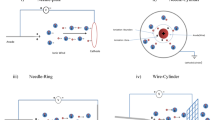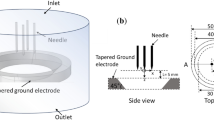Abstract
A heat sink for cooling devices using the counter flow of a corona wind was developed in this study. Detailed information about the numerical investigations of forced convection using the corona wind was presented. The fins of the heat sink using the counter flow of a corona wind were also investigated. The corona wind generator with a wire-to-plate electrode arrangement was used for generating the counter flow to the fin. The compact and simple geometric characteristics of the corona wind generator facilitate the application of the heat sink using the counter flow, demonstrating the heat sink is effective for cooling electronic devices. Parametric studies were performed to analyze the effect of the counter flow on the fins. Also, the velocity and temperature were measured experimentally for the test mock-up of the heat sink with the corona wind generator to verify the numerical results. From a numerical study, the type of fin and its optimal height, length, and pitch were suggested for various heat fluxes. In addition, the correlations to calculate the mass of the developed heat sink and its cooling performance in terms of the heat transfer coefficient were derived. Finally, the cooling efficiencies corresponding to the mass, applied power, total size, and noise of the devices were compared with the existing commercial central processing unit (CPU) cooling devices with rotor fans. As a result, it was confirmed that the heat sink using the counter flow of the corona wind showed appropriate efficiencies for cooling electronic devices, and is a suitable replacement for the existing cooling device for high power electronics.














Similar content being viewed by others
Abbreviations
- Vc :
-
Onset voltage [kV]
- E:
-
Electric field intensity [V/m]
- q:
-
Space charge [C]
- є:
-
Dielectric permittivity
- D:
-
Diffusivity coefficient of ions
- U:
-
Velocity of air flow [m/s]
- K:
-
Ion mobility
- J:
-
Current density [A/cm3]
- μ:
-
Coefficient of viscosity [N·s/m2]
- fe :
-
Coulomb force [N]
- p:
-
Pressure [Pa]
- h:
-
Heat transfer coefficient [W/m2·K]
- Ts :
-
Surface temperature [°C]
- T∞ :
-
Ambient temperature [°C]
- ρ:
-
Density of air [g/cm3]
- λ:
-
Thermal conductivity [W/m·k]
- he :
-
Enthalpy [kcal]
- htot :
-
Total enthalpy [kcal]
- τ:
-
Friction [N]
- U :
-
Velocity vector of flow
- q ,, :
-
Heat flux [W/m2]
References
Yang Y-T, Peng H-S (2008) Numerical study of pin-fin heat sink with un-uniform fin height design. Int J Heat Mass Transf 51(19–20):4788–4796. https://doi.org/10.1016/j.ijheatmasstransfer.2008.02.017
Huang C-H, Chen Y-H, Li H-Y (2013) An impingement heat sink module design problem in determining optimal non-uniform fin widths. Int J Heat Mass Transf 67:992–1006. https://doi.org/10.1016/j.ijheatmasstransfer.2013.08.103
Huang C-H, Chen Y-H (2014) An impingement heat sink module design problem in determining simultaneously the optimal non-uniform fin widths and heights. Int J Heat Mass Transf 73:627–633. https://doi.org/10.1016/j.ijheatmasstransfer.2014.02.026
Balagopal S, Go DB (2011) Counter-flow ionic winds for localized hot spot cooling In: proceeding of ESA Annual Meeting on Electrostatics' 11
Fylladitakis ED, Moronis AX, Kiousis K (2014) Design of a prototype EHD air pump for electronic chip cooling applications. Plasma Sci Technol 16(5):491–501. https://doi.org/10.1088/1009-0630/16/5/09
Sheu WJ, Hsiao JJ, Wang CC (2013) Effect of oscillatory EHD on the heat transfer performance of a flat plate. Int J Heat Mass Transf 61(1):419–424. https://doi.org/10.1016/j.ijheatmasstransfer.2013.02.026
Chen IY, Guo MZ, Yang KS, Wang CC (2013) Enhanced cooling for LED lighting using ionic wind. Int J Heat Mass Transf 57(1):285–291. https://doi.org/10.1016/j.ijheatmasstransfer.2012.10.015
Lakeh RB, Molki M (2013) Enhancement of convective heat transfer by electrically-induced swirling effect in laminar and fully-developed internal flows. J Electrost 71(6):1086–1099
Go DB, Maturana RA, Fisher TS, Garimella SV (2008) Enhancement of external forced convection by ionic wind. Int J Heat Mass Transf 51(25–26):6047–6053. https://doi.org/10.1016/j.ijheatmasstransfer.2008.05.012
Rashkovan A, Sher E, Kalman H (2002) Experimental optimization of an electric blower by corona wind. Appl Therm Eng 22(14):1587–1599. https://doi.org/10.1016/S1359-4311(02)00082-0
Peek FW (1920) Dielectric Phenomena in High Voltage Engineering, 2nd edn. McGraw-Hill, New York, pp 38–71
Shin DH, Yoon JS, Ko HS (2015) Experimental optimization of ion wind generator with needle to parallel plates for cooling device. Int J Heat Mass Transf 84:35–45. https://doi.org/10.1016/j.ijheatmasstransfer.2015.01.018
Shin DH, Baek SH, Ko HS (2016) Development of heat sink with ionic wind for LED cooling. Int J Heat Mass Transf 93:516–528. https://doi.org/10.1016/j.ijheatmasstransfer.2015.10.029
Chiriac VA, Ortega A (2002) A numerical study of the unsteady flow and heat transfer in a transitional confined slot jet impinging on an isothermal surface. Int J Heat Mass Transf 45(6):1237–1248. https://doi.org/10.1016/S0017-9310(01)00224-1
Yoo JH, Hong JI, Cao W (2000) Piezoelectric ceramic bimorph coupled to thin metal plate as cooling fan for electronic devices. Sensors Actuators A Phys 79(1):8–12. https://doi.org/10.1016/S0924-4247(99)00249-6
SH Y, Lee KS, Yook SJ (2011) Optimum design of a radial heat sink under natural convection. Int J Heat Mass Transf 54(11):2499–2505. https://doi.org/10.1016/j.ijheatmasstransfer.2011.02.012
SH Y, Lee KS, Yook SJ (2011) Natural convection around a radial heat sink. Int J Heat Mass Transf 53(13):2935–2938. https://doi.org/10.1016/j.ijheatmasstransfer.2010.02.032
Jang D, SH Y, Lee SK (2012) Multidisciplinary optimization of a pin-fin radial heat sink for LED lighting applications. Int J Heat Mass Transf 55(4):515–521. https://doi.org/10.1016/j.ijheatmasstransfer.2011.11.016
Jang D, SH Y, Lee SK (2014) Optimum design of a radial heat sink with a fin-height profile for high-power LED lighting applications. Appl Energy 116:260–268. https://doi.org/10.1016/j.apenergy.2013.11.063
Wu K, Wang L, Yu B, Huang ZY, Liang P (2013) Luminaries-level structure improvement of LEDs for heat dissipation enhancement under natural convection. Sadhana 38(6):1357–1368. https://doi.org/10.1007/s12046-013-0157-x; Springer
Elshafei EAM (2010) Natural convection heat transfer from a heat sink with hollow/perforated circular pin fins. Energy 35(7):2870–2877. https://doi.org/10.1016/j.energy.2010.03.016
Martins AA (2012) Simulation of a wire-cylinder-plate positive corona discharge in nitrogen gas at atmospheric pressure. Physics of Plasmas (1994-present) 19(6):063502
Wilcox DC (2008) Formulation of the kw Turbulence Model Revisited. AIAA J 46(11):2823–2838
Victor AC, Alfonso O (2002) A numerical study of the unsteady flow and heat transfer in a transitional confined slot jet impinging on an isothermal surface. Int J Heat Mass Transf 45(6):1237–1248. https://doi.org/10.1016/S0017-9310(01)00224-1
Acknowledgements
This work was supported by the Basic Science Research Program through the National Research Foundation of Korea (NRF), funded by the Korean government (MEST) (2016R1A2B4011087).
Author information
Authors and Affiliations
Corresponding author
Ethics declarations
Conflict of interest
On behalf of all authors, the corresponding author states that there is no conflict of interest.
Rights and permissions
About this article
Cite this article
Shin, D.H., Baek, S.H. & Ko, H.S. Analysis of counter flow of corona wind for heat transfer enhancement. Heat Mass Transfer 54, 841–854 (2018). https://doi.org/10.1007/s00231-017-2183-4
Received:
Accepted:
Published:
Issue Date:
DOI: https://doi.org/10.1007/s00231-017-2183-4




